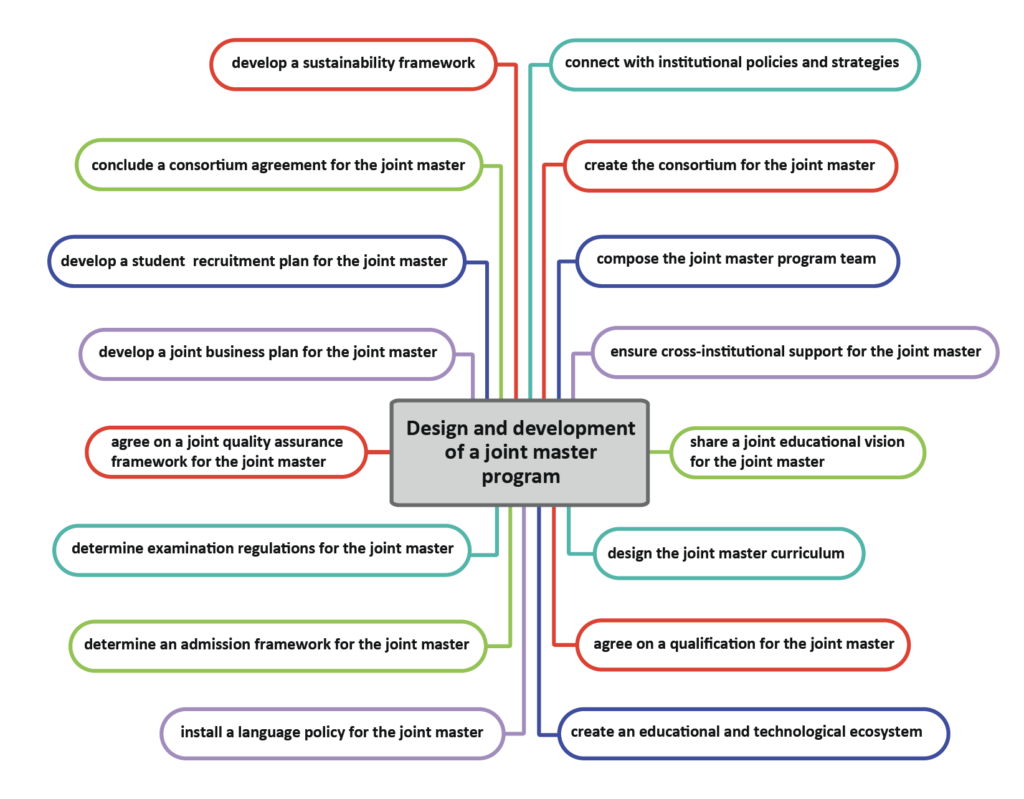
Development steps
Designing and developing joint master’s programmes is a complex activity that involves several steps:
• link the programme to the institution’s macro-objectives related to broader institutional strategies such as promoting a structural and sustainable academic cooperation between universities; creating an international academic experience for students; developing high- quality cooperation in European University Initiative alliances (EUI) and other networks; creating high-quality flexible continuing education and professional development; and developing attractive and competitive master’s programmes for the international recruitment of talented students;
• create the partnership with a clear identity in the field, by inviting universities based on trust and previous collaborations or common interests in research and innovation. Involve non-degree awarding partners for co-design, co-development or co-delivery, if this is preferred for the target group envisaged;
• assemble a course team led by a competent course team leader, share leadership with key personnel of the respective institutions and involve teachers in the implementation of the programme. Define the roles of the partnership related to programme design and development; the implementation of the programme; admission, exams and qualifications; quality assurance, continuous evaluation and accreditation; the educational and technological ecosystem; recruitment of students; the business plan and the sustainability framework;
• Provide (cross-)institutional support through teaching and learning, internationalisation, ICT for education and legal services and the student administration;
• share a joint educational vision on the joint master’s degree, based on a needs analysis; defining an academic and professional profile; describing the intended characteristics of the student; defining the macro-objectives and a unique selling point of the master’s programme and defining the relationship with other master’s programmes;
• design the programme according to state-of-the-art principles, ensuring that it can be successfully developed and implemented, defining the intended learning outcomes and competences, designing a coherent curriculum in content and structure; aligning delivery modes, media and tools; designing room for flexibility; enhancing the student learning experience ; determining the study load; making the programme inclusive and designing student and staff mobility modes.
• agree on the joint qualification to be awarded, justifying the diploma to be recognized; agreeing on the name of the joint master’s degree and possibly on a corresponding professional qualification; defining any modular qualifications; agreeing on the descriptors for the diploma supplement;
• create an educational and technological ecosystem for the joint master’s, by selecting a digital learning environment; sharing educational and technological resources, access to libraries and other facilities and to research and innovation in the partner universities;
• introduce a language policy to make the programme accessible to the whole partnership and to wider geographical areas;
• establish an admission framework with joint admission criteria, a joint application and admission procedure, including credential evaluation and joint registration for the degree programme;
• establish joint examination regulations, including the organization of the examinations, a joint grading system and rules for awarding a joint master’s degree;
• agree on a common quality assurance framework, involving institutional frameworks for quality assurance and compliance with accreditation requirements;
• Develop a joint business plan, balancing public funding, student enrollment fees and funding from external stakeholders;
• Develop an international student recruitment plan, including multi-segment recruitment campaigns;
- conclude a consortium agreement in which responsibilities and tasks are laid down;
- develop a sustainability framework, with a commitment from universities for at least five years to ensure basic sustainability; an annual institutional evaluation and improvement plan and a sustainable financial framework.
Observations
• Expertise in the design and development of joint master’s programmes and related mobility is increasing at all levels, in particular through the involvement of universities in Erasmus Mundus programmes (European Commission, 2021). This strengthens the scientific basis for designing and developing joint master’s degree programmes;
• EUI alliances cooperate in many areas on joint programmes at bachelor, master’s and doctoral level and in continuing education and provide a natural environment for the development of joint master’s (European Commission, 2021);
• EIT Knowledge Innovation Communities develop and recognize international master’s programmes in their respective priority areas (European Commission, 2021);
• The European Commission has prepared a proposal for Recommendation to the Council of Education Ministers on a framework for microcredentials (European Commission, 2021), which will stimulate the modularization of university education and the development of continuing education and professional development. This is part of the Digital Education Action Plan (European Commission, 2020) and the European Education Area (European Commission, 2020).
next chapter: Connect with institutional policies and strategies
previous chapter: A joint master’s programme: the concept
back to overview: Models and guidelines for the design and development of joint master’s programmes
